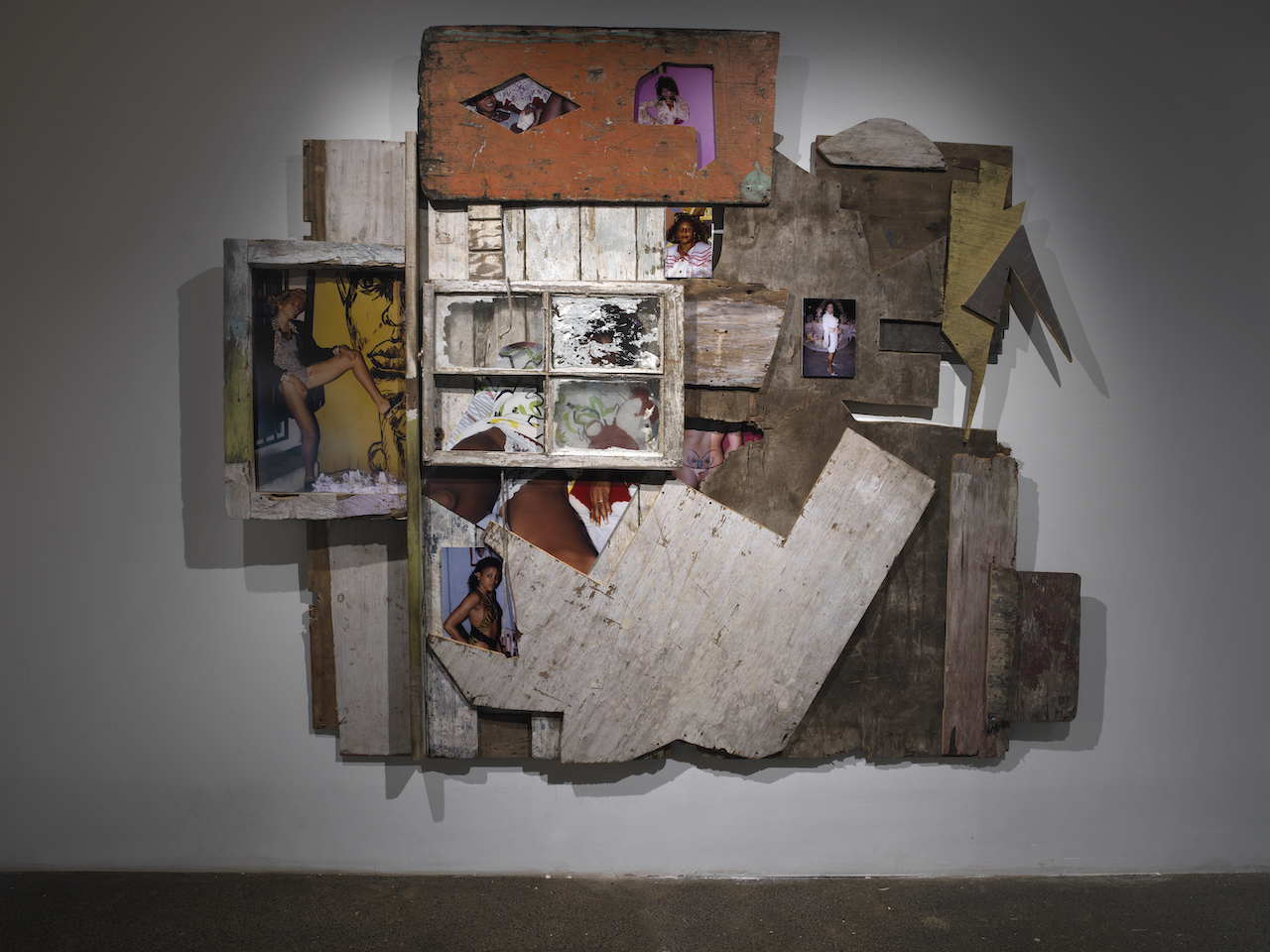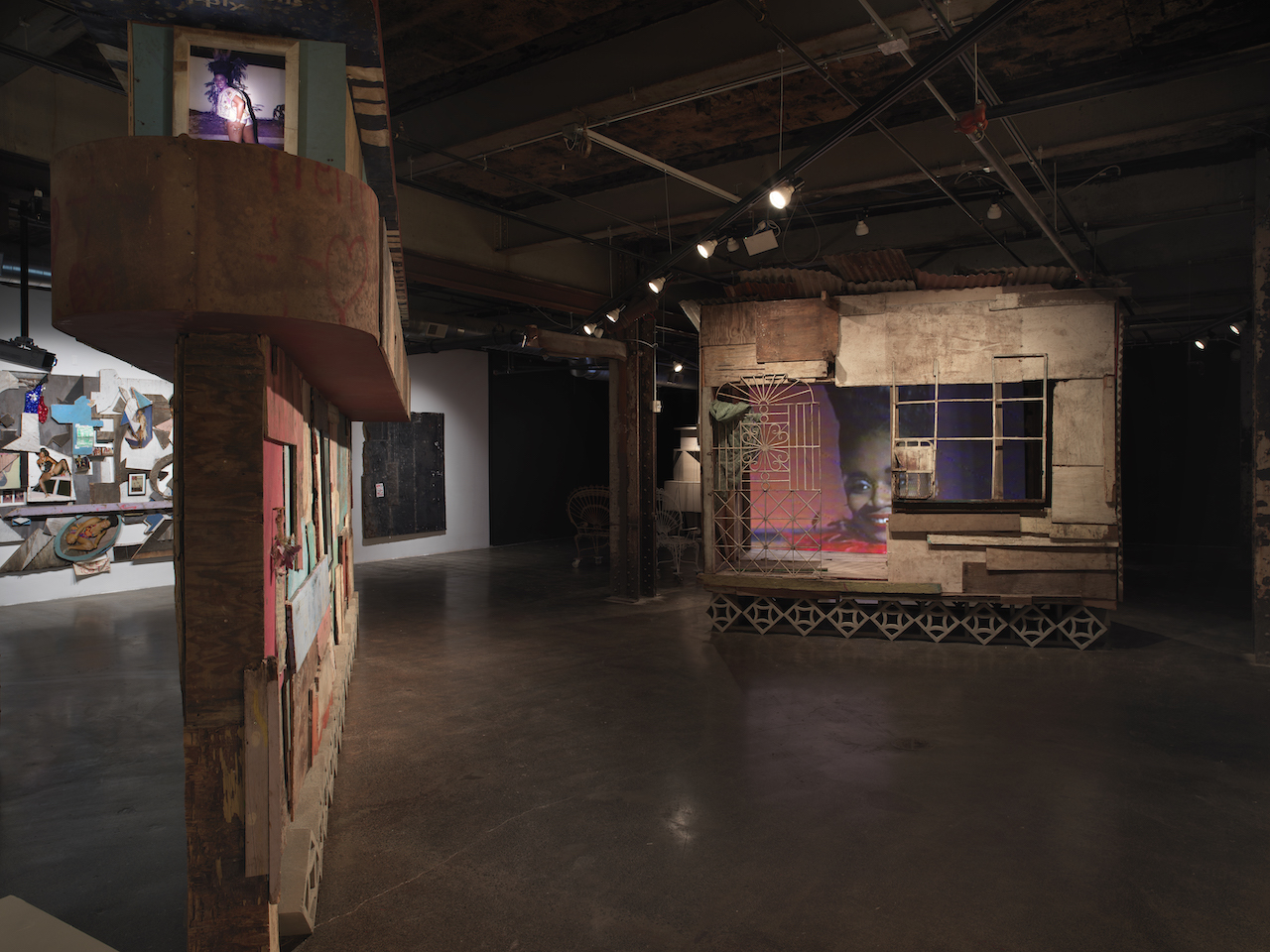
No Gyal Can Test
Akeem Smith
April 19th - July 31st, 2021
Red Bull Arts
Detroit
Traversing the slippages between memory, the archive, and
history, No Gyal Can Test excavates the personal photographs
and videos entrusted to the artist Akeem Smith over the past
decade by family members, friends, and prominent figures at
the heart of Kingston’s dancehall community. Pulling its title
from a hand-written note scrawled on the back of a photo
sent to his father, the exhibition draws upon Smith’s experience
growing up between New York and Kingston in an attempt to
record a collective memory that exists at the edges of the artist’s
own. In his first solo exhibition, an homage to the women who
raised him, Smith presents two video installations and a series
of large-scale multimedia interventions formed from salvaged
architectural remnants transplanted from Kingston. Carefully
housed within these vessels like relics, the archival photographs,
videos, ephemera, and period artifacts coalesce as a lyrical
reconstitution of a social world gone but not yet forgotten.
Emerging in the late 1970s during a moment of accelerated hybridity and political transformation, dancehall was a movement situated between two epochs—one defined by the country’s decolonization and the formation of an indigenous national identity; the other by its culture’s currency as a popular force felt throughout the digitally networked present. Though it was a movement born from the local gatherings formed around the sound systems scattered across Kingston’s inner city, dancehall radiated outward through its cultural diaspora, both influencing and metabolizing the increasingly accessible aspirations and influences of the cultures it circulated through.
Just one moment in a longer history of Jamaica’s Black majority, dancehall is part of a lineage that has managed to persist through the centuries despite a legislated and socially reinforced deculturation that extends to the plantation period. Appearing spectacularly for moments, and at others unrecorded and fugitive, this history is one with multiple origins and end points that troubles the very notions of cultural purity or reconciliation. Rather than apolitical, as its detractors often claim it to be, dancehall’s supposed frivolity exceeded and short-circuited the visibility so desired by previous generations. For Smith, dancehall’s contribution to posterity must always be remembered with its women positioned at the center of the movement’s legacy.
While those unacquainted with his archive might simply see a community centered around celebration, to those familiar, the era was messy, personal, and hierarchical, with loyalties, gossip, highs and lows, and knowledge of where everyone ended up. This interwovenness, much like what is found in the depths of any archive, challenges the still common idea that there is a primary history to which these regional, “vernacular,” or personal histories are secondary—perhaps especially in a country with the motto “Out of Many, One People.” With all that is lost in encountering this history within the white cube, No Gyal Can Test contends with the inevitable voyeurism that results from transposing these lived experiences across cultural, economic, and temporal divides.
Largely absent from institutional archives, documentation of Jamaica’s popular movements are still commonly seen in the eyes of Jamaica’s socio-economic elite as unwanted clutter rather than treasured national heritage. Smith counters this through the construction of monumental reliquaries, which house these corroding testaments within the material landscape of corrugated zinc, tarp, repurposed wood, and breeze blocks from which they came. Composed of the marked, residual traces of a former life, these structures are also ruins in reverse, and the possibilities once envisioned within them are rejuvenated with renewed hope. Falling into the abstract time of memories and dreams, Smith places the viewer somewhere between formerly imagined (and now remembered) utopias and a distant, nostalgic future both entropic and far away.
This exhibition would not have been possible without the trust of innumerable members of the dancehall community and their faith in Smith’s artistic vision. A deeply personal journey that has resulted in sought-after spiritual growth, No Gyal Can Test is a love letter to not only the women who raised him, but to the intrepid spirit of the people of Jamaica and a contribution to the evolving shadow archives of the Black experience. In the context of our hyper-mediated, socially distanced present, it’s hard to ignore the illuminations of a past that speak to the fundamental need within all of us to gather in community. As an insider and outsider both, Smith is in the unique position to navigate the gaps between Jamaican and American culture, the aspirations of the era and the realities of its legacy, and the often-conflicting roles of the documented and the documen- tarian. The distinct bonds and insular language of a community of color, first seen through a young person’s eyes, offer the potential for a lifetime’s work.
Emerging in the late 1970s during a moment of accelerated hybridity and political transformation, dancehall was a movement situated between two epochs—one defined by the country’s decolonization and the formation of an indigenous national identity; the other by its culture’s currency as a popular force felt throughout the digitally networked present. Though it was a movement born from the local gatherings formed around the sound systems scattered across Kingston’s inner city, dancehall radiated outward through its cultural diaspora, both influencing and metabolizing the increasingly accessible aspirations and influences of the cultures it circulated through.
Just one moment in a longer history of Jamaica’s Black majority, dancehall is part of a lineage that has managed to persist through the centuries despite a legislated and socially reinforced deculturation that extends to the plantation period. Appearing spectacularly for moments, and at others unrecorded and fugitive, this history is one with multiple origins and end points that troubles the very notions of cultural purity or reconciliation. Rather than apolitical, as its detractors often claim it to be, dancehall’s supposed frivolity exceeded and short-circuited the visibility so desired by previous generations. For Smith, dancehall’s contribution to posterity must always be remembered with its women positioned at the center of the movement’s legacy.
While those unacquainted with his archive might simply see a community centered around celebration, to those familiar, the era was messy, personal, and hierarchical, with loyalties, gossip, highs and lows, and knowledge of where everyone ended up. This interwovenness, much like what is found in the depths of any archive, challenges the still common idea that there is a primary history to which these regional, “vernacular,” or personal histories are secondary—perhaps especially in a country with the motto “Out of Many, One People.” With all that is lost in encountering this history within the white cube, No Gyal Can Test contends with the inevitable voyeurism that results from transposing these lived experiences across cultural, economic, and temporal divides.
Largely absent from institutional archives, documentation of Jamaica’s popular movements are still commonly seen in the eyes of Jamaica’s socio-economic elite as unwanted clutter rather than treasured national heritage. Smith counters this through the construction of monumental reliquaries, which house these corroding testaments within the material landscape of corrugated zinc, tarp, repurposed wood, and breeze blocks from which they came. Composed of the marked, residual traces of a former life, these structures are also ruins in reverse, and the possibilities once envisioned within them are rejuvenated with renewed hope. Falling into the abstract time of memories and dreams, Smith places the viewer somewhere between formerly imagined (and now remembered) utopias and a distant, nostalgic future both entropic and far away.
This exhibition would not have been possible without the trust of innumerable members of the dancehall community and their faith in Smith’s artistic vision. A deeply personal journey that has resulted in sought-after spiritual growth, No Gyal Can Test is a love letter to not only the women who raised him, but to the intrepid spirit of the people of Jamaica and a contribution to the evolving shadow archives of the Black experience. In the context of our hyper-mediated, socially distanced present, it’s hard to ignore the illuminations of a past that speak to the fundamental need within all of us to gather in community. As an insider and outsider both, Smith is in the unique position to navigate the gaps between Jamaican and American culture, the aspirations of the era and the realities of its legacy, and the often-conflicting roles of the documented and the documen- tarian. The distinct bonds and insular language of a community of color, first seen through a young person’s eyes, offer the potential for a lifetime’s work.




























